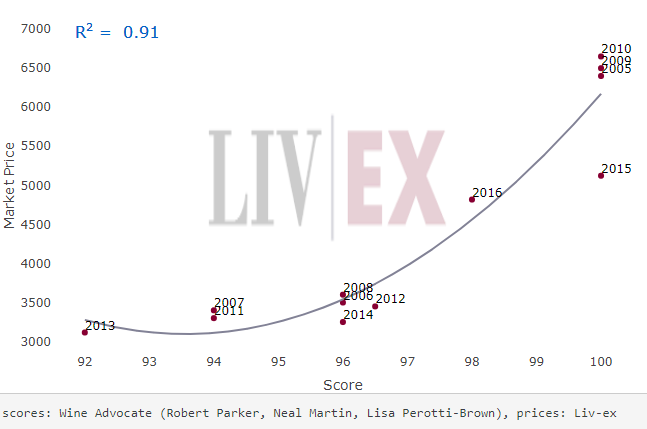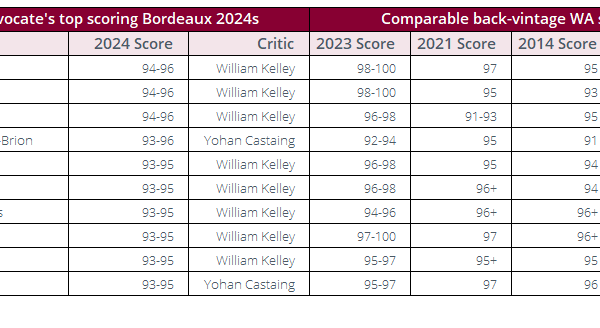About ‘fair value’
Liv-ex uses regression analysis, a process for estimating the relationship between two variables, to map the relationship between prices and critic scores. Taking Haut Brion as an example below, scores and prices for the most recent 12 vintages are plotted against each other to create a trend line.
Liv-ex’s ‘fair value’ methodology accounts for the fact that the relationship between price and critic score for most of Bordeaux’s fine wine is not linear. Beyond a certain score, the relationship between price and score is typically exponential. This means that additional points have an increasingly large impact on price. However, additional points for lower scoring wines have little or no impact on price.
The R-squared value is used to measure how close data points are to the fitted regression line. R-squared is always between 0 and 100%. In general, the higher the R-squared, the better the regression line (or ‘trend line’) fits the data. For example, the R-squared in the Haut Brion model below is 90% which represents a very close fit. In statistical terms, the R-squared measures how much of the variation in price can be explained by variations in score.
For models that have a high R-squared – generally a value above 50% – the trend line can be used to estimate a ‘fair value’ for a particular wine given its score. The model can also be used to identify potential pricing anomalies in the secondary market. Vintages that lie above the trend line are assumed to be trading at a premium to ‘fair value’, while those below it at a discount. In the example below, the 100-point Haut Brion 2015 (Lisa Perotti-Brown) appears to be priced significantly below the trend line and might therefore offer value to buyers.
Haut Brion: Price vs score

Using fair value to price En Primeur
Similarly, the trend line can be used to approximate a Market Price for an En Primeur wine once it has been scored. In the example above, with a score of 94-96 (Neal Martin), the fair value of Haut Brion 2017 would be around £3,200 using the mid-point score of 95.
However, buying En Primeur is riskier than buying back vintages in bottle. Therefore, it is expected that En Primeur would be priced at a discount to the trend line, on average. Of course, there will be exceptions to this. For example, a 95-point wine in an exceptional vintage may warrant a ‘vintage premium’ to the price of the same 96-point wine in an average vintage, as demonstrated in our report Bordeaux 2016 – A New Dawn for En Primeur? In these cases, ‘fair value’ represents a valuable and transparent starting point for subsequent negotiations over that premium.
For some wines, age has a greater influence on price than score does. This may be because buyers are seeking exposure to a particular brand and are prepared to pay a premium based on age. Prices for Beychevelle, for example, are more closely correlated to their age (70%) than their score (15%), suggesting that age is the key influencer of price.
What are the limitations of ‘fair value’?
Liv-ex’s ‘fair value’ methodology is intended to be simple and transparent. It uses information from the secondary market to help identify a fair price for a wine, given its score. If more appropriate, its age is used instead. In order to use ‘fair value’ effectively, users must also understand its limitations.
The model does not account for differences in ‘vintage premiums’ over and above that already captured by differences in score. As in the previous example, a 97-point wine in an exceptional vintage may warrant a premium to the price of an identical 97-point wine in an average vintage. This means that the data in the regression models is somewhat biased.
An attempt can be made to quantify this bias by looking at the average premium or discount to the trend line across vintages. This is explored in more detail in our report, Bordeaux 2016 – A New Dawn for En Primeur?
In theory, a more complicated regression model could be built to account for such bias. In practice, we prefer to keep the model as simple as possible at this stage.
A note on scores
Historically, there would have been little question that Robert Parker was the critic with the greatest influence on the prices of Bordeaux. Since his retirement, the waters have muddied. Last year we continued to use The Wine Advocate almost exclusively on our charts; the exception being for wines that were released before the publication’s Bordeaux 2016 report, written by Neal Martin, came out.
Recent years have seen a number of movements in the critic world. In February, Neal Martin joined Antonio Galloni at Vinous. Both have now published their own separate reports on En Primeur. We have also seen Lisa Perotti-Brown MW, The Wine Advocate’s Editor-in-Chief, take on Bordeaux reviewing responsibilities while Jeb Dunnuck has left TWA to create his own publication. Last year, Decanter announced that it would be moving away from the panel model and appointing Jane Anson as its primary Bordeaux critic.
All of this has made the task of analysing En Primeur more interesting and nuanced than it has been before. It also complicates the process of analysing price according to score. After some thought, we decided to put the question of which critic(s) to follow to our members who represent the majority of the global wine trade. In a survey, we asked them to rank the critics according to who they would most closely follow for En Primeur coverage. Respondents pointed clearly to Neal Martin: over 70% named him in first place. It is for this reason that the blogs on our charts will show Neal’s score this year. For continuity, we will use the official Wine Advocate scores for back vintages.
In theory, scores from any critic can be used to evaluate price. In practice, for our fair value methodology to work, a strong correlation between price and score is needed. This is not the case for the majority of wine critics for the simple reason that Parker had such a strong influence on price historically. In mathematical terms, Parker is the determinant. Still, Liv-ex members will be given the opportunity to evaluate price using the critics of their own choosing with our price analysis tool. Using this, they can decide for themselves when the evidence is strong enough to inform buying or selling decisions.
Another issue that has repeatedly been raised is the usefulness of average scores, which we are increasingly seeing around the web. Alongside critic scores and notes, average scores can provide useful reference points. However, calculating meaningful, weighted, averages is complicated. Global Wine Score, which is run by Scorelab in Bordeaux, offers a comprehensive solution to this. You can find out more about the methodology here and you will be able to find GWS scores for the vintage on our summary page.
While we will use Neal’s scores on charts, and quote heavily from his report and notes, we’ll also be referring to the opinions of other key critics throughout the campaign. It’s important to give a broad and balanced context for understanding the new releases, and there are many other critics that the trade follow heavily according to our survey.
Following our analysis
Throughout the campaign, we will be blogging on all of the major releases on Liv-ex Insights. You can also view key critic scores here and key prices here.
To keep up-to-date, follow us on Twitter and subscribe to our weekly blog email below.
[mc4wp_form id=”18204″]



